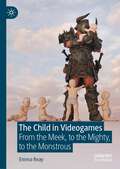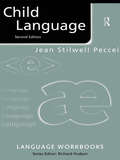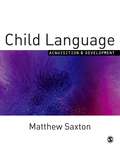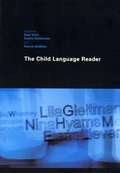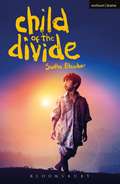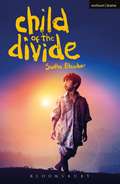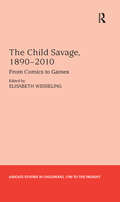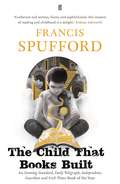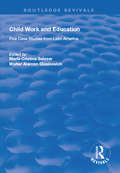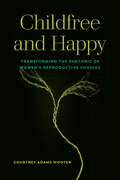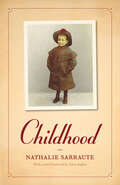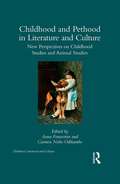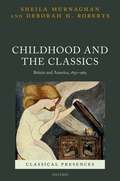- Table View
- List View
The Child in Videogames: From the Meek, to the Mighty, to the Monstrous
by Emma ReayDrawing across Games Studies, Childhood Studies, and Children’s Literature Studies, this book redirects critical conversations away from questions of whether videogames are ‘good’ or ‘bad’ for child-players and towards questions of how videogames produce childhood as a set of social roles and rules in contemporary Western contexts. It does so by cataloguing and critiquing representations of childhood across a corpus of over 500 contemporary videogames. While child-players are frequently the topic of academic debate – particularly within the fields of psychology, behavioural science, and education research - child-characters in videogames are all but invisible. This book's aim is to make these child-characters not only visible, but legible, and to demonstrate that coded kids in virtual worlds can shed light on how and why the boundaries between adults and children are shifting.
Child Language: A Resource Book For Students
by Jean Stilwell PecceiChild Language: provides a comprehensive overview of language acquisition in children introduces students to key theories and concerns such as innateness, the role of input and the relation of language to other cognitive functions teaches students the skills needed to analyze children's language includes sections on the bilingual child and atypical language development provides classic readings by key names in the field, such as Brian MacWhinney, Richard Cromer, Jean Aitchison, and Eve Clark. The accompanying website to this book can be found at http://www. routledge. com/textbooks/0415281032
Child Language
by Jean Stilwell PecceiBuilding on the established strengths of the first edition, Child Language has now been fully updated and includes some basic theory content, more exercises and summaries at the end of each unit. Child Language:* introduces students to key areas involved in the study of children's language: vocabulary development, word and sentence structure, conversational skills and pronunciation* contains a corpus of children's language* includes suggestions for project work.
Child Language
by Jean Stilwell PecceiBuilding on the established strengths of the first edition, Child Language has now been fully updated and includes some basic theory content, more exercises and summaries at the end of each unit. Child Language:* introduces students to key areas involved in the study of children's language: vocabulary development, word and sentence structure, conversational skills and pronunciation* contains a corpus of children's language* includes suggestions for project work.
Child Language: Acquisition and Development (1st edition) (PDF)
by Matthew SaxtonPresented with the latest thinking and research on how children acquire their first language, the reader is taken from a standing start to the point where they can engage with key debates and current research in the field of child language. No background knowledge of linguistic theory is assumed and all specialist terms are introduced in clear, non-technical language. A theme running through the book is the nature-nurture debate, rekindled in the modern era by Noam Chomsky, with his belief that the child is born with a rich knowledge of language. This book is rare in its balanced presentation of evidence from both sides of the nature-nurture divide. The reader is encouraged to adopt a critical stance throughout and weigh up the evidence for themselves. Key features for the student include: boxes and exercises to foster an understanding of key concepts in language and linguistics; a glossary of key terms; suggestions for further reading; a list of useful websites at the end of each chapter; discussion points for use in class; and separate author and subject indexes. 9781412902328
The Child Language Reader (PDF)
by Kate Trott Sushie Dobbinson Patrick GriffithsThe Child Language Reader provides an introduction to the most important research in child language acquisition and development. Including extensive editorial introductions, which explain key background, assumptions and terminology, and organized into thematic sections, it brings the reader into direct contact with original research, in a supported and guided environment. Features include: *articles written by a range of international authors, including classics by influential figures *coverage of a number of language development areas, including phonology, semantics, sociolinguistics, methodology and bilingualism *a substantial section on methodology, offering practical insight into the design of child language research *an appendix on statistical analysis *a new piece by Brian Richards and David Malvern. Covering a range of different theoretical standpoints, The Child Language Reader offers a comprehensive overview of the field, and is a definitive resource for anyone with an interest in child language.
Child of the Divide (Modern Plays)
by Sudha BhucharI have a boy. He is across the border, I know he is.A few miles between. The same starsShine on himSummer 1947. Sixteen million people are on the move between India and the newly-formed Pakistan. Amid the violent political upheaval, young Pali's fingers slip from his father's hand, and his destiny changes forever.Lost, dispossessed and alone, Pali is saved by a Muslim family. The boy is given a new home and new family, a new name, a new faith and a new life. But seven years later, his real father returns to claim him and Pali's life is turned upside down again. He is forced to decide who he is: the Hindu boy he was born to be, the Muslim boy he has become, or simply a child of the divide.This edition has been published to mark the 70th anniversary of the partition of India and a new high-profile production originating once again at the Polka Theatre. Sudha Bhuchar's remarkable story of family, identity and belonging set against a fractured landscape is a fictionalised account of real experiences, of families torn apart and of stolen pasts, where friendship and love are found in unexpected places.
Child of the Divide (Modern Plays)
by Sudha BhucharI have a boy. He is across the border, I know he is.A few miles between. The same starsShine on himSummer 1947. Sixteen million people are on the move between India and the newly-formed Pakistan. Amid the violent political upheaval, young Pali's fingers slip from his father's hand, and his destiny changes forever.Lost, dispossessed and alone, Pali is saved by a Muslim family. The boy is given a new home and new family, a new name, a new faith and a new life. But seven years later, his real father returns to claim him and Pali's life is turned upside down again. He is forced to decide who he is: the Hindu boy he was born to be, the Muslim boy he has become, or simply a child of the divide.This edition has been published to mark the 70th anniversary of the partition of India and a new high-profile production originating once again at the Polka Theatre. Sudha Bhuchar's remarkable story of family, identity and belonging set against a fractured landscape is a fictionalised account of real experiences, of families torn apart and of stolen pasts, where friendship and love are found in unexpected places.
The Child Savage, 1890–2010: From Comics to Games (Studies in Childhood, 1700 to the Present)
by Elisabeth WesselingTaking up the understudied relationship between the cultural history of childhood and media studies, this volume traces twentieth-century migrations of the child-savage analogy from colonial into postcolonial discourse across a wide range of old and new media. Older and newer media such as films, textbooks, children's literature, periodicals, comic strips, children's radio, and toys are deeply implicated in each other through ongoing 'remediation', meaning that they continually mimic, absorb and transform each other's representational formats, stylistic features, and content. Media theory thus confronts the cultural history of childhood with the challenge of re-thinking change in childhood imaginaries as transformation-through-repetition patterns, rather than as rise-shine-decline sequences. This volume takes up this challenge, demonstrating that one historical epoch may well accommodate diverging childhood repertoires, which are recycled again and again as they are played out across a whole gamut of different media formats in the course of time.
The Child Savage, 1890–2010: From Comics to Games (Studies in Childhood, 1700 to the Present)
by Elisabeth WesselingTaking up the understudied relationship between the cultural history of childhood and media studies, this volume traces twentieth-century migrations of the child-savage analogy from colonial into postcolonial discourse across a wide range of old and new media. Older and newer media such as films, textbooks, children's literature, periodicals, comic strips, children's radio, and toys are deeply implicated in each other through ongoing 'remediation', meaning that they continually mimic, absorb and transform each other's representational formats, stylistic features, and content. Media theory thus confronts the cultural history of childhood with the challenge of re-thinking change in childhood imaginaries as transformation-through-repetition patterns, rather than as rise-shine-decline sequences. This volume takes up this challenge, demonstrating that one historical epoch may well accommodate diverging childhood repertoires, which are recycled again and again as they are played out across a whole gamut of different media formats in the course of time.
The Child that Books Built: A Memoir Of Childhood And Reading
by Francis SpuffordChildren's books - from Narnia to The Hobbit - are celebrated in this enlightened examination of the joys of childhood reading.Fairy tales and Where the Wild Things Are, The Lord of the Rings and the Narnia books, Little House on the Prairie and The Earthsea Trilogy. What would you find if you went back and re-read your favourite books from childhood? Francis Spufford discovers both delight and sadness, in this widely celebrated memoir of a boy who retreats into books, faced with a tragedy in his family.'A beautifully composed and wholly original memoir, sounding the classics of children's literature.' David Sexton, Evening Standard'Exuberant and serious, funny and sophisticated, this memoir of reading and childhood is a delight.' Andrea Ashworth
Child Work and Education: Five Case Studies from Latin America (Routledge Revivals)
by Walter Alarcon Glasinovich María Cristina SalazarPublished in 1998. In recent years research, as well as the results of practical programmes, has led to a clearer understanding of the relationship between child work and education. It is increasingly evident that child work is not entirely the result of economic need or exploitation. Frequently is the failure of educational system to offer adequate, stimulating and affordable schooling that encourages children to drop out in favour of work that appears to offer advantages more relevant to their everyday lives. Parents too may undervalue the role and purpose of a school that provides inadequate preparation for the future and often see a job, including home-based work, as a positive alternative to crime, delinquency or begging. Consequently, while a distinction needs to be made between ‘formative child work’ and ‘harmful child work’, in certain situations and cultures the phenomenon is not always seen as negative. Yet, although gratifying in the short term and sometimes even providing the means for a younger child to attend school as well as a way of learning discipline and responsibility, often these jobs provide no useful experience and do not lead to an improvement in the personal development of life chances of a child. The situation is therefore complex and requires a more realistic evolution of the relationship between archaic pedagogy, dropout rates and child work. These five case studies from Latin America all reveal the effects of inappropriate school curricular. Desertion of the educational system for the labour market leads to inadequate training and perpetuates the poverty trap. As part of the commitment to combating work which is detrimental to the child, major educational reform is needed. Improvements in coverage, quality and affordability should lead to greater acceptance pf schooling at all levels of society and provide a greater incentive for parents and children alike to participate more fully in the system. Moreover, in cases of severe economic hardship and forced or harmful labour, practical assistance with subsides and scholarships should be considered to remove children from such work.
Child Work and Education: Five Case Studies from Latin America (Routledge Revivals)
by MARÍA CRISTINA SALAZAR AND WALTER ALARCÓN GLASINOVICHPublished in 1998. In recent years research, as well as the results of practical programmes, has led to a clearer understanding of the relationship between child work and education. It is increasingly evident that child work is not entirely the result of economic need or exploitation. Frequently is the failure of educational system to offer adequate, stimulating and affordable schooling that encourages children to drop out in favour of work that appears to offer advantages more relevant to their everyday lives. Parents too may undervalue the role and purpose of a school that provides inadequate preparation for the future and often see a job, including home-based work, as a positive alternative to crime, delinquency or begging. Consequently, while a distinction needs to be made between ‘formative child work’ and ‘harmful child work’, in certain situations and cultures the phenomenon is not always seen as negative. Yet, although gratifying in the short term and sometimes even providing the means for a younger child to attend school as well as a way of learning discipline and responsibility, often these jobs provide no useful experience and do not lead to an improvement in the personal development of life chances of a child. The situation is therefore complex and requires a more realistic evolution of the relationship between archaic pedagogy, dropout rates and child work. These five case studies from Latin America all reveal the effects of inappropriate school curricular. Desertion of the educational system for the labour market leads to inadequate training and perpetuates the poverty trap. As part of the commitment to combating work which is detrimental to the child, major educational reform is needed. Improvements in coverage, quality and affordability should lead to greater acceptance pf schooling at all levels of society and provide a greater incentive for parents and children alike to participate more fully in the system. Moreover, in cases of severe economic hardship and forced or harmful labour, practical assistance with subsides and scholarships should be considered to remove children from such work.
Childfree and Happy: Transforming the Rhetoric of Women's Reproductive Choices
by Courtney Adams WootenChildfree and Happy examines how millennia of reproductive beliefs (or doxa) have positioned women who choose not to have children as deviant or outside the norm. Considering affect and emotion alongside the lived experiences of women who have chosen not to have children, Courtney Adams Wooten offers a new theoretical lens to feminist rhetorical scholars’ examinations of reproductive rhetorics and how they circulate through women’s lives by paying attention not just to spoken or written beliefs but also to affectual circulations of reproductive doxa. Through interviews with thirty-four childfree women and analysis of childfree rhetorics circulating in historical and contemporary texts and events, this book demonstrates how childfree women individually and collectively try to speak back to common beliefs about their reproductive experiences, even as they struggle to make their identities legible in a sociocultural context that centers motherhood. Childfree and Happy theorizes how affect and rhetoric work together to circulate reproductive doxa by using Sara Ahmed’s theories of gendered happiness scripts to analyze what reproductive doxa is embedded in those scripts and how they influence rhetoric by, about, and around childfree women. Delving into how childfree women position their decision not to have children and the different types of interactions they have with others about this choice, including family members, friends, colleagues, and medical professionals, Childfree and Happy also explores how communities that make space for alternative happiness scripts form between childfree women and those who support them. It will be of interest to scholars in the fields of the rhetoric of motherhood/mothering, as well as feminist rhetorical studies.
Childhood
by Nathalie SarrauteAs one of the leading proponents of the nouveau roman, Nathalie Sarraute is often remembered for her novels, including The Golden Fruits, which earned her the Prix international de litterature in 1964. But her carefully crafted and evocative memoir Childhood may in fact be Sarraute’s most accessible and emotionally open work. Written when the author was eighty-three years old, but dealing with only the first twelve years of her life, Childhood is constructed as a dialogue between Sarraute and her memory. Sarraute gently interrogates her interlocutor in search of her own intentions, more precise accuracy, and indeed, the truth. Her relationships with her mother in Russia and her stepmother in Paris are especially heartbreaking: long-gone actions are prodded and poked at by Sarraute until they yield some semblance of fact, imbuing these maternalistic interactions with new, deeper meaning. Each vignette is bristling with detail and shows the power of memory through prose by turns funny, sad, and poetic. Capturing the ambience of Paris and Russia in the earliest part of the twentieth century, while never giving up the lyrical style of Sarraute’s novels, this book has much to offer both memoir enthusiasts and fiction lovers.
Childhood
by Nathalie SarrauteAs one of the leading proponents of the nouveau roman, Nathalie Sarraute is often remembered for her novels, including The Golden Fruits, which earned her the Prix international de litterature in 1964. But her carefully crafted and evocative memoir Childhood may in fact be Sarraute’s most accessible and emotionally open work. Written when the author was eighty-three years old, but dealing with only the first twelve years of her life, Childhood is constructed as a dialogue between Sarraute and her memory. Sarraute gently interrogates her interlocutor in search of her own intentions, more precise accuracy, and indeed, the truth. Her relationships with her mother in Russia and her stepmother in Paris are especially heartbreaking: long-gone actions are prodded and poked at by Sarraute until they yield some semblance of fact, imbuing these maternalistic interactions with new, deeper meaning. Each vignette is bristling with detail and shows the power of memory through prose by turns funny, sad, and poetic. Capturing the ambience of Paris and Russia in the earliest part of the twentieth century, while never giving up the lyrical style of Sarraute’s novels, this book has much to offer both memoir enthusiasts and fiction lovers.
Childhood
by Nathalie SarrauteAs one of the leading proponents of the nouveau roman, Nathalie Sarraute is often remembered for her novels, including The Golden Fruits, which earned her the Prix international de litterature in 1964. But her carefully crafted and evocative memoir Childhood may in fact be Sarraute’s most accessible and emotionally open work. Written when the author was eighty-three years old, but dealing with only the first twelve years of her life, Childhood is constructed as a dialogue between Sarraute and her memory. Sarraute gently interrogates her interlocutor in search of her own intentions, more precise accuracy, and indeed, the truth. Her relationships with her mother in Russia and her stepmother in Paris are especially heartbreaking: long-gone actions are prodded and poked at by Sarraute until they yield some semblance of fact, imbuing these maternalistic interactions with new, deeper meaning. Each vignette is bristling with detail and shows the power of memory through prose by turns funny, sad, and poetic. Capturing the ambience of Paris and Russia in the earliest part of the twentieth century, while never giving up the lyrical style of Sarraute’s novels, this book has much to offer both memoir enthusiasts and fiction lovers.
Childhood
by Nathalie SarrauteAs one of the leading proponents of the nouveau roman, Nathalie Sarraute is often remembered for her novels, including The Golden Fruits, which earned her the Prix international de litterature in 1964. But her carefully crafted and evocative memoir Childhood may in fact be Sarraute’s most accessible and emotionally open work. Written when the author was eighty-three years old, but dealing with only the first twelve years of her life, Childhood is constructed as a dialogue between Sarraute and her memory. Sarraute gently interrogates her interlocutor in search of her own intentions, more precise accuracy, and indeed, the truth. Her relationships with her mother in Russia and her stepmother in Paris are especially heartbreaking: long-gone actions are prodded and poked at by Sarraute until they yield some semblance of fact, imbuing these maternalistic interactions with new, deeper meaning. Each vignette is bristling with detail and shows the power of memory through prose by turns funny, sad, and poetic. Capturing the ambience of Paris and Russia in the earliest part of the twentieth century, while never giving up the lyrical style of Sarraute’s novels, this book has much to offer both memoir enthusiasts and fiction lovers.
Childhood and Pethood in Literature and Culture: New Perspectives in Childhood Studies and Animal Studies (Children's Literature and Culture)
by Anna Feuerstein Carmen Nolte-OdhiamboBringing together new perspectives in childhood studies and animal studies, this book is the first collection to critically address the manifold alignments and frequent co-constitutions of children and pets in our families, our cultures, and our societies. The cultural politics of power shaping relationships between children, pets, and adults inform the wide range of essays included in this collection, as they explore issues such as protection, discipline, mastery, wildness, play, and domestication. The volume use the frequent social and cultural intersections between children and pets as an opportunity to analyze institutions that create pet and child subjectivity, from education and training to putting children and pets on display for entertainment purposes. Essays analyze legal discourses, visual culture, literature for children and adults, migration narratives, magazines for children, music, and language socialization to discuss how notions of nationalism, race, gender, heteronormativity, and speciesism shape cultural constructions of children and pets. Examining childhood and pethood in America, Europe, Asia, and the Pacific, this collection shows how discourses linking children and pets are pervasive and work across cultures. By presenting innovative approaches to the child and the pet, the book brings to light alternative paths toward understanding these figures, leading to new openings and questions about kinship, agency, and the power of care that so often shapes our relationships with children and animals. This will be an important volume for scholars of animal studies, childhood studies, children’s literature, cultural studies, political theory, education, art history, and sociology.
Childhood and Pethood in Literature and Culture: New Perspectives in Childhood Studies and Animal Studies (Children's Literature and Culture)
by Anna Feuerstein Carmen Nolte-OdhiamboBringing together new perspectives in childhood studies and animal studies, this book is the first collection to critically address the manifold alignments and frequent co-constitutions of children and pets in our families, our cultures, and our societies. The cultural politics of power shaping relationships between children, pets, and adults inform the wide range of essays included in this collection, as they explore issues such as protection, discipline, mastery, wildness, play, and domestication. The volume use the frequent social and cultural intersections between children and pets as an opportunity to analyze institutions that create pet and child subjectivity, from education and training to putting children and pets on display for entertainment purposes. Essays analyze legal discourses, visual culture, literature for children and adults, migration narratives, magazines for children, music, and language socialization to discuss how notions of nationalism, race, gender, heteronormativity, and speciesism shape cultural constructions of children and pets. Examining childhood and pethood in America, Europe, Asia, and the Pacific, this collection shows how discourses linking children and pets are pervasive and work across cultures. By presenting innovative approaches to the child and the pet, the book brings to light alternative paths toward understanding these figures, leading to new openings and questions about kinship, agency, and the power of care that so often shapes our relationships with children and animals. This will be an important volume for scholars of animal studies, childhood studies, children’s literature, cultural studies, political theory, education, art history, and sociology.
Childhood and the Classics: Britain and America, 1850-1965 (Classical Presences)
by Sheila Murnaghan Deborah H. RobertsThe dissemination of classical material to children has long been a major form of popularization with far-reaching effects, although until very recently it has received almost no attention within the growing field of classical reception studies. This volume explores the ways in which children encountered the world of ancient Greece and Rome in Britain and the United States over a century-long period beginning in the 1850s, as well as adults' literary responses to their own childhood encounters with antiquity. Rather than discussing the role of classics in education, it focuses on books read for enjoyment, and on two genres of children's literature in particular: the myth collection and the historical novel. The tradition of myths retold as children's stories is traced in the work of writers and illustrators from Nathaniel Hawthorne and Charles Kingsley to Roger Lancelyn Green and Ingri and Edgar Parin D'Aulaire, while the discussion of historical fiction focuses particularly on the roles of nationality and gender in the construction of an ancient world for modern children. The book concludes with an investigation of the connections between childhood and antiquity made by writers for adults, including James Joyce, Virginia Woolf, and H.D. Recognition of the fundamental role in children's literature of adults' ideas about what children want or need is balanced throughout by attention to the ways in which child readers have made such works their own. The formative experiences of antiquity discussed throughout help to explain why despite growing uncertainty about the appeal of antiquity to modern children, the classical past remains perennially interesting and inspiring.
Childhood and the Classics: Britain and America, 1850-1965 (Classical Presences)
by Sheila Murnaghan Deborah H. RobertsThe dissemination of classical material to children has long been a major form of popularization with far-reaching effects, although until very recently it has received almost no attention within the growing field of classical reception studies. This volume explores the ways in which children encountered the world of ancient Greece and Rome in Britain and the United States over a century-long period beginning in the 1850s, as well as adults' literary responses to their own childhood encounters with antiquity. Rather than discussing the role of classics in education, it focuses on books read for enjoyment, and on two genres of children's literature in particular: the myth collection and the historical novel. The tradition of myths retold as children's stories is traced in the work of writers and illustrators from Nathaniel Hawthorne and Charles Kingsley to Roger Lancelyn Green and Ingri and Edgar Parin D'Aulaire, while the discussion of historical fiction focuses particularly on the roles of nationality and gender in the construction of an ancient world for modern children. The book concludes with an investigation of the connections between childhood and antiquity made by writers for adults, including James Joyce, Virginia Woolf, and H.D. Recognition of the fundamental role in children's literature of adults' ideas about what children want or need is balanced throughout by attention to the ways in which child readers have made such works their own. The formative experiences of antiquity discussed throughout help to explain why despite growing uncertainty about the appeal of antiquity to modern children, the classical past remains perennially interesting and inspiring.
Childhood as Memory, Myth and Metaphor: Proust, Beckett, and Bourgeois
by Catherine Crimp"A fascination with childhood unites the artist Louise Bourgeois (1911-2010) and the writers Samuel Beckett (1906-89) and Marcel Proust (1871-1922). But while many commentators have traced their childhood images back to memories of lived experiences, there is more to their mythologies of childhood that waits to be explored. They invite us to move away from familiar ideas - whether psychological or biographical - about what a child can represent, and even what a child is. The haunting child figures of Bourgeois, Beckett and Proust echo each other as they show how imagining origins- for a life, for a work of art - involves paradoxes that test the limits of our forms of expression. Art meets literature, profusion meets concision, French meets English, and images of childhood reveal new insights in this encounter between three great figures of twentieth- and twenty-first-century culture. Catherine Crimp holds a PhD from the University of Cambridge and is currently Lectrice d'anglais at theEcole Normale Superieure de Lyon."
Childhood as Memory, Myth and Metaphor: Proust, Beckett, and Bourgeois
by Catherine Crimp"A fascination with childhood unites the artist Louise Bourgeois (1911-2010) and the writers Samuel Beckett (1906-89) and Marcel Proust (1871-1922). But while many commentators have traced their childhood images back to memories of lived experiences, there is more to their mythologies of childhood that waits to be explored. They invite us to move away from familiar ideas - whether psychological or biographical - about what a child can represent, and even what a child is. The haunting child figures of Bourgeois, Beckett and Proust echo each other as they show how imagining origins- for a life, for a work of art - involves paradoxes that test the limits of our forms of expression. Art meets literature, profusion meets concision, French meets English, and images of childhood reveal new insights in this encounter between three great figures of twentieth- and twenty-first-century culture. Catherine Crimp holds a PhD from the University of Cambridge and is currently Lectrice d'anglais at theEcole Normale Superieure de Lyon."
Childhood, Autobiography and the Francophone Caribbean (Contemporary French and Francophone Cultures #24)
by Louise HardwickThis book examines a major modern turn in Francophone Caribbean literature towards the récit d'enfance, or childhood memoir, and asks why this occurred post-1990, connecting texts to recent changes in public policy and education policy concerning the commemoration of slavery and colonialism both in France and at a global level (for example, the UNESCO project 'La Route de l'esclave', the 'loi Taubira' and the 'Comité pour la mémoire de l'esclavage'). Combining approaches from Postcolonial Theory, Psychoanalysis, Trauma Theory and Gender Studies, and positing recognition as a central concept of postcolonial literature, it draws attention to a neglected body of récits d'enfance by contemporary bestselling, prize-winning Francophone Caribbean authors Patrick Chamoiseau, Maryse Condé, Gisèle Pineau, Daniel Maximin, Raphaël Confiant and Dany Laferrière, while also offering new readings of texts by Aimé Césaire, Frantz Fanon, Edouard Glissant, Joseph Zobel, Françoise Ega, Michèle Lacrosil, Maurice Virassamy and Mayotte Capécia. The study proposes an innovative methodological paradigm with which to read postcolonial childhoods in a comparative framework from areas as diverse as the Caribbean, North Africa, Sub-Saharan Africa and particularly the Haitian diaspora in North America.
